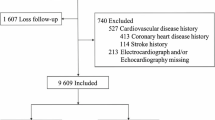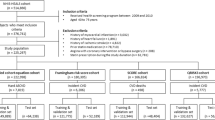Abstract
Introduction
Atherosclerotic cardiovascular disease (ASCVD) is the first leading cause of mortality globally. To identify the individual risk factors of ASCVD utilizing the machine learning (ML) approaches.
Materials & methods
This cohort-based cross-sectional study was conducted on data of 500 participants with ASCVD among Tabriz University Medical Sciences employees, during 2020. The data with ML methods were developed and validated to predict ASCVD risk with naive Bayes (NB), spurt vesture machines (SVM), regression tree (RT), k-nearest neighbors (KNN), artificial neural networks (ANN), generalized additive models (GAM), and logistic regression (LR).
Results
Accuracy of the models ranged from 95.7 to 98.1%, with a sensitivity of 50.0 to 97.3%, specificity of 74.3 to 99.1%, positive predictive value (PPV) of 0.0 to 98.0%, negative predictive value (NPV) of 68.4 to 100.0%, positive likelihood ratio (LR +) of 13.8 to 96.4%, negative likelihood ratio (LR-) of 3.6 to 51.9%, and area under ROC curve (AUC) of 62.5 to 99.4%. The ANN fit the data best with an accuracy of 98.1% (95% CI: 96.5–99.1), a specificity of 99.1% (95% CI: 97.7–99.9), a LR + of 96.4% (95% CI: 36.2–258.8), and AUC of 99.4% (95% CI: 85.2–97.0). Based on the optimal model, sex (females), age, smoking, and metabolic syndrome were shown to be the most important risk factors of ASCVD.
Conclusion
Sex (females), age, smoking, and metabolic syndrome were predictors obtained by ANN. Considering the ANN as the optimal model identified, more accurate prevention planning may be designed.



Similar content being viewed by others
Data availability
The data that support the findings of this study are available from MAJ, but restrictions are applied to the availability of these data, which were used under license for the current study, and are not publicly available. Data are, however, available from the authors upon reasonable request by MAJ.
Code availability
All precision used in this study was carried out by STATISTICA software which is menu based the for the is no code available.
References
Barquera S, Pedroza-Tobías A, Medina C, Hernández-Barrera L, Bibbins-Domingo K, Lozano R, et al. Global overview of the epidemiology of atherosclerotic cardiovascular disease. Arch Med Res. 2015;46(5):328–38. https://doi.org/10.1016/j.arcmed.2015.06.006.
Hadaegh F, Asgari S, Moosaie F, Orangi M, Sarvghadi F, Khalili D, et al. The risk and added values of the atherosclerotic cardiovascular risk enhancers on prediction of cardiovascular events: Tehran lipid and glucose study. J Transl Med. 2021;19(1):1–14. https://doi.org/10.1186/s12967-020-02686-1.
Sarrafzadegan N, Mohammmadifard N. Cardiovascular disease in Iran in the last 40 years: prevalence, mortality, morbidity, challenges and strategies for cardiovascular prevention. Arch Iran Med. 2019;22(4):204–10.
Hong YM. Atherosclerotic cardiovascular disease beginning in childhood. Korean Circ J. 2010;40(1):1–9. https://doi.org/10.4070/kcj.2010.40.1.1.
Kavey R-EW, Daniels SR, Lauer RM, Atkins DL, Hayman LL, Taubert K. American Heart Association guidelines for primary prevention of atherosclerotic cardiovascular disease beginning in childhood. Circulation. 2003;107(11):1562–6. https://doi.org/10.1161/01.CIR.0000061521.15730.6E.
Virani SS, Alonso A, Aparicio HJ, Benjamin EJ, Bittencourt MS, Callaway CW, et al. Heart disease and stroke statistics—2021 update: a report from the American Heart Association. Circulation. 2021;143(8):e254–743. https://doi.org/10.1161/CIR.0000000000000950.
Li Q, Campan A, Ren A, Eid WE. Automating and improving cardiovascular disease prediction using Machine learning and EMR data features from a regional healthcare system. Int J Med Informatics. 2022;163:104786. https://doi.org/10.1016/j.ijmedinf.2022.104786.
Azizi F, Hadaegh F, Hosseinpanah F, Mirmiran P, Amouzegar A, Abdi H, et al. Metabolic health in the Middle East and north Africa. Lancet Diabetes Endocrinol. 2019;7(11):866–79. https://doi.org/10.1016/S2213-8587(19)30179-2.
Zibaeenejad F, Mohammadi SS, Sayadi M, Safari F, Zibaeenezhad MJ. Ten-year atherosclerosis cardiovascular disease (ASCVD) risk score and its components among an Iranian population: a cohort-based cross-sectional study. BMC Cardiovasc Disord. 2022;22(1):1–8. https://doi.org/10.1186/s12872-022-02601-0.
Levenson JW, Skerrett PJ, Gaziano JM. Reducing the global burden of cardiovascular disease: the role of risk factors. Prev Cardiol. 2002;5(4):188–99. https://doi.org/10.1111/j.1520-037x.2002.00564.x.
Grundy SM, Stone NJ, Bailey AL, Beam C, Birtcher KK, Blumenthal RS, et al. 2018 AHA/ACC/AACVPR/AAPA/ABC/ACPM/ADA/AGS/APhA/ASPC/NLA/PCNA guideline on the management of blood cholesterol: executive summary: a report of the American College of Cardiology/American Heart Association Task Force on Clinical Practice Guidelines. J Am Coll Cardiol. 2019;73(24):3168–209. https://doi.org/10.1016/j.jacc.2018.11.002.
Dc JG, Lloyd-Jones D, Bennett G, Coady S, D’Agostino R, Gibbons R, et al. 2013 ACC/AHA guideline on the assessment of cardiovascular risk: a report of the American College of Cardiology/American Heart Association Task Force on Practice Guidelines. Circulation. 2014. https://doi.org/10.1161/01.cir.0000437741.48606.98.
Surendran S, Mithun C, Moni M, Tiwari A, Pradeep M. Cardiovascular risk assessment using ASCVD risk score in fibromyalgia: a single-centre, retrospective study using “traditional” case control methodology and “novel” machine learning. Adv Rheumatol. 2021; 61. https://doi.org/10.1186/s42358-021-00229-w.
Lloyd-Jones DM, Braun LT, Ndumele CE, Smith SC Jr, Sperling LS, Virani SS, et al. Use of risk assessment tools to guide decision-making in the primary prevention of atherosclerotic cardiovascular disease: a special report from the American Heart Association and American College of Cardiology. Circulation. 2019;139(25):e1162–77. https://doi.org/10.1161/CIR.0000000000000638.
Jaiswal S, Natarajan P, Silver AJ, Gibson CJ, Bick AG, Shvartz E, et al. Clonal hematopoiesis and risk of atherosclerotic cardiovascular disease. N Engl J Med. 2017;377(2):111–21. https://doi.org/10.1056/NEJMoa1701719.
Rodriguez F, Chung S, Blum MR, Coulet A, Basu S, Palaniappan LP. Atherosclerotic cardiovascular disease risk prediction in disaggregated Asian and Hispanic subgroups using electronic health records. J Am Heart Assoc. 2019;8(14):e011874. https://doi.org/10.1161/JAHA.118.011874.
Jamialahmadi T, Baratzadeh F, Reiner Ž, Simental-Mendía LE, Xu S, Susekov AV, et al. The Effects of Statin Dose, Lipophilicity, and Combination of Statins plus Ezetimibe on Circulating Oxidized Low-Density Lipoprotein Levels: A Systematic Review and Meta-Analysis of Randomized Controlled Trials. Mediat Inflamm. 2021;2021. https://doi.org/10.1155/2021/9661752.
Graham I, Cooney M-T, Bradley D, Dudina A, Reiner Z. Dyslipidemias in the prevention of cardiovascular disease: risks and causality. Curr Cardiol Rep. 2012;14(6):709–20. https://doi.org/10.1007/s11886-012-0313-7.
Association AD. 8 Cardiovascular disease and risk management. Diabetes Care. 2016;39(Supplement_1):S60–71. https://doi.org/10.2337/dc16-S011.
Lai C-C, Huang W-H, Chang BC-C, Hwang L-C. Development of Machine Learning Models for Prediction of Smoking Cessation Outcome. Int J Environ Res Pub Health. 2021;18(5):2584. https://doi.org/10.3390/ijerph18052584.
Sanchez-Cabo F, Rossello X, Fuster V, Benito F, Manzano JP, Silla JC, Fernández-Alvira JM, Oliva B, Fernandez-Friera L, Lopez-Melgar B, Mendiguren JM. Machine learning improves cardiovascular risk definition for young, asymptomatic individuals. J Am Coll Cardiol. 2020;76(14):1674–85. https://doi.org/10.1016/j.jacc.2020.08.017
Smith SC Jr, Blair SN, Bonow RO, Brass LM, Cerqueira MD, Dracup K, et al. AHA/ACC guidelines for preventing heart attack and death in patients with atherosclerotic cardiovascular disease: 2001 update: a statement for healthcare professionals from the American Heart Association and the American College of Cardiology. Circulation. 2001;104(13):1577–9. https://doi.org/10.1161/hc3801.097475.
Ward A, Sarraju A, Chung S, Li J, Harrington R, Heidenreich P, et al. Machine learning and atherosclerotic cardiovascular disease risk prediction in a multi-ethnic population. NPJ Digit Med. 2020;3(1):1–7. https://doi.org/10.1038/s41746-020-00331-1.
Sidey-Gibbons JA, Sidey-Gibbons CJ. Machine learning in medicine: a practical introduction. BMC Med Res Methodol. 2019;19(1):1–18. https://doi.org/10.1186/s12874-019-0681-4.
Friedman CP, Wong AK, Blumenthal D. Achieving a nationwide learning health system. Sci Transl Med. 2010;2(57):57cm29-57cm29. https://doi.org/10.1126/scitranslmed.3001456.
Deo RC. Machine learning in medicine. Circulation. 2015;132(20):1920–30. https://doi.org/10.1161/CIRCULATIONAHA.115.001593.
Handelman G, Kok H, Chandra R, Razavi A, Lee M, Asadi H. eD octor: machine learning and the future of medicine. J Intern Med. 2018;284(6):603–19. https://doi.org/10.1111/joim.12822.
Farhang S, Faramarzi E, Amini Sani N, Poustchi H, Ostadrahimi A, Alizadeh BZ, et al. Cohort profile: The AZAR cohort, a health-oriented research model in areas of major environmental change in Central Asia. Int J Epidemiol. 2019;48(2):382-h. https://doi.org/10.1093/ije/dyy215.
Collins GS, Reitsma JB, Altman DG, Moons KG. Transparent reporting of a multivariable prediction model for individual prognosis or diagnosis (TRIPOD): the TRIPOD statement. J Br Surg. 2015;102(3):148–58. https://doi.org/10.1101/2020.06.15.20130328.
Von Elm E, Altman DG, Egger M, Pocock SJ, Gøtzsche PC, Vandenbroucke JP, et al. The Strengthening the Reporting of Observational Studies in Epidemiology (STROBE) statement: guidelines for reporting observational studies. Ann Intern Med. 2007;147(8):573–7. https://doi.org/10.7326/0003-4819-147-8-200710160-00010.
Hussain L, Aziz W, Khan IR, Alkinani MH, Alowibdi JS. Machine learning based congestive heart failure detection using feature importance ranking of multimodal features. Math Biosci Eng. 2021;18(1):69–91. https://doi.org/10.3934/mbe.2021004.
Shim J-G, Ryu K-H, Cho E-A, Ahn JH, Kim HK, Lee Y-J, et al. Machine Learning Approaches to Predict Chronic Lower Back Pain in People Aged over 50 Years. Medicina. 2021;57(11):1230. https://doi.org/10.3390/medicina57111230.
Isler Y, Narin A, Ozer M. Comparison of the effects of cross-validation methods on determining performances of classifiers used in diagnosing congestive heart failure. Meas Sci Rev. 2015;15(4):196.
Jamthikar AD, Gupta D, Saba L, Khanna NN, Viskovic K, Mavrogeni S, et al. Artificial intelligence framework for predictive cardiovascular and stroke risk assessment models: A narrative review of integrated approaches using carotid ultrasound. Comput Biol Med. 2020;126:104043. https://doi.org/10.1016/j.compbiomed.2020.104043.
Jee SH, Suh I, Kim IS, Appel LJ. Smoking and atherosclerotic cardiovascular disease in men with low levels of serum cholesterol: the Korea Medical Insurance Corporation Study. JAMA. 1999;282(22):2149–55. https://doi.org/10.1001/jama.282.22.2149.
Acknowledgements
We would like to appreciate the collaboration of the department of biostatistics and epidemiology, Faculty of Health, and Tabriz University of medical sciences, for providing the environment for modeling data and manuscript writing.
Funding
This study was supported by a research deputy of Tabriz University of medical sciences.
Author information
Authors and Affiliations
Contributions
All authors read and approved the final manuscript. MAJ and PE conceived the study and participated in the design and data collection. MAJ, PE, NR, SM, SG, and NMA participated in the data analysis and manuscript preparation.
Corresponding author
Ethics declarations
Ethics approval
The institutional review board of Tabriz University of medical sciences approved the protocol of the study (ethics code: IR.TBZMED.REC.1400.1006).
Consent to participate
The participants' privacy was preserved. All participants filled and signed the informed consent and assent. All methods were carried out in accordance with relevant guidelines and regulations.
Consent for publication
Not applicable.
Competing interests
The authors have no relevant financial or non-financial interests to disclose.
Additional information
Publisher's note
Springer Nature remains neutral with regard to jurisdictional claims in published maps and institutional affiliations.
Rights and permissions
Springer Nature or its licensor (e.g. a society or other partner) holds exclusive rights to this article under a publishing agreement with the author(s) or other rightsholder(s); author self-archiving of the accepted manuscript version of this article is solely governed by the terms of such publishing agreement and applicable law.
About this article
Cite this article
Esmaeili, P., Roshanravan, N., Mousavi, S. et al. Machine learning framework for atherosclerotic cardiovascular disease risk assessment. J Diabetes Metab Disord 22, 423–430 (2023). https://doi.org/10.1007/s40200-022-01160-7
Received:
Accepted:
Published:
Issue Date:
DOI: https://doi.org/10.1007/s40200-022-01160-7




